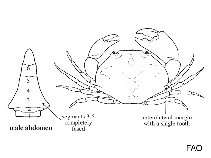Carpilius corallinus (Herbst, 1783)
Batwing coral crab| Native range | All suitable habitat | Point map | Year 2050 |

|
| This map was computer-generated and has not yet been reviewed. |
| Carpilius corallinus AquaMaps Data sources: GBIF OBIS |
Google image | No image available for this species;
drawing shows typical species in Carpiliidae.
Classification / Names Common names | Synonyms | CoL | ITIS | WoRMS
Malacostraca | Decapoda | Carpiliidae
Environment: milieu / climate zone / depth range / distribution range Ecology
Benthic; depth range 1 - 50 m (Ref. 101362), usually 1 - 20 m (Ref. 116371). Tropical; 33°N - 25°S, 98°W - 34°W
Distribution Countries | FAO areas | Ecosystems | Occurrences | Introductions
Western Atlantic: From Florida, the Gulf of Mexico and Antilles to Venezuela and Brazil. Tropical to subtropical.
Length at first maturity / Size / Weight / Age
Maturity: Lm ? range ? - ? cm Max length : 15.0 cm CW male/unsexed; (Ref. 101376)
Life cycle and mating behavior Maturity | Reproduction | Spawning | Eggs | Fecundity | Larvae
Main reference
References | Coordinator | Collaborators
Laughlin, R.A. 1982 Some observations on the occurrence, reproduction and mating of the coral crab Carpilius corallinus (Herbst, 1783) (Decapoda, Xanthidae) in the Archipielago Los Roques, Venezuela. Crustaceana 43(2):219-221. (Ref. 101362)
IUCN Red List Status
(Ref. 130435: Version 2025-1)
CITES status (Ref. 108899)
CMS (Ref. 116361)
Threat to humans
Human uses
Fisheries: commercial
| FishSource | Sea Around Us
Tools
More information
Max. ages / sizes
Length-weight rel.
Length-length rel.
Length-frequencies
Mass conversion
Abundance
Internet sources
BHL | BOLD Systems | CISTI | DiscoverLife | FAO(Publication : search) | Fishipedia | GenBank (genome, nucleotide) | GloBI | Gomexsi | Google Books | Google Scholar | Google | PubMed | Tree of Life | Wikipedia (Go, Search) | Zoological Record



